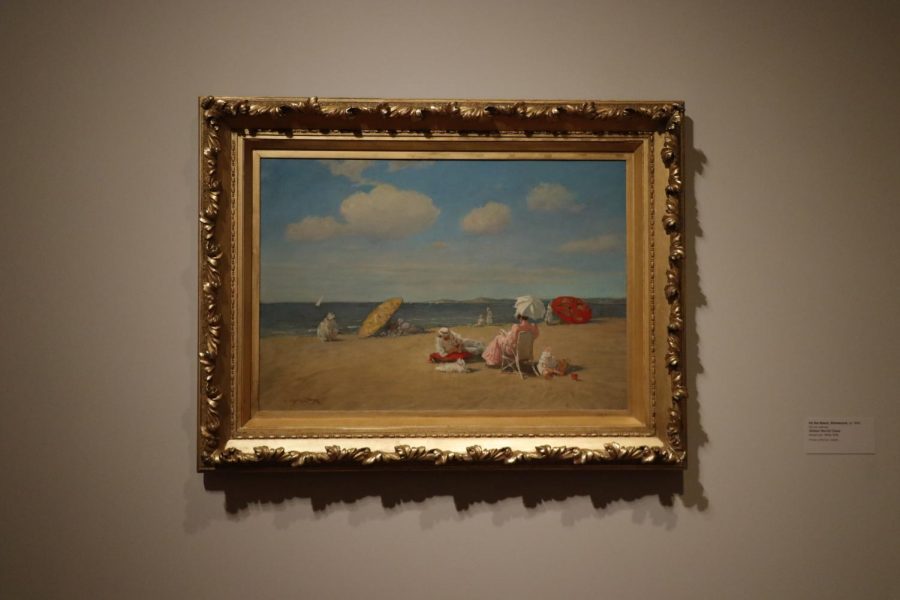So You Think Museums Are Boring?
A DYING INDUSTRY This is one of the many paintings that are slowly using value due to our societies interest in brain-washing technology. This painting shows a wealthy family relaxing on the beach, one of my favorites.
December 2, 2019
I started off my research like I would any article. I was eager to search the vast internet for the best quotes about why museums are so fascinating, or facts about museums’ high visitation percentages. Unfortunately, I was left-empty handed and disappointed by the numerous articles about how museums are a bore. An article written by CNN even said that museums are “graveyards of stuff,” which bewildered me. Astounding museums were being needlessly criticized. I had always believed that museums were calming places where one could go to and think and observe beautifully crafted pieces of art, which I soon realized was an unpopular opinion. So I decided to look at my article a different way. I wanted people to understand what it was about museums that kept me coming back for more.
Coming across the fact in a recent study by Humanities Indicators, “In 2017, 24% of the U.S. adult population had visited a museum or art gallery in the previous year,” left me heartbroken. That meant most U.S adults had never visited a museum that year, and they have no idea what they are missing out on. What was it about museums that bored people so much? Sophomore Maclaren Crow brought to my attention that generations have continually became progressively more and more interested in their phones than anything else. Crow says, “It’s hard for us to focus on things for a long time; even when you’re on your phone, you’re switching through apps a lot. You get bored of one thing or you get bored of talking to one person and so being at a museum and looking at the same types of things over and over again is kind of boring.” This made sense to me, but I still did not feel satisfied. I now know why teens are not interested in museums, but how can museums start to direct their services to younger crowds to get them involved? Students at Issaquah High School suggested lots of different ways. Senior Alex Amedson says that museums should “have a bigger influence in schools, maybe talking about them in schools or giving students the opportunity to go visit a museum for fun for a field trip,” and Junior Sofia Fiorini thinks that “advertising and using more current things to try and grab their attention” would help museums more. Either way, whether it is more merchandise, adding music to the background, or even making the museums more hands on, it could drastically change people’s opinions for the better.
According to the Institute of Museum and Library Services, “There are 35,144 museums in the U.S.,” one of those being the Smithsonian, located in Washington D.C. The Smithsonian was ranked number one for “Top 10 Museums and Galleries” by National Geographic. This encouraged me even more to get the word out about the excellence of museums, as the U.S. is lucky to have so many successful ones near us.
I attended the Seattle Art Museum to see if I was in over my head. Luckily, I enjoyed every minute of it and was in absolute awe. I pranced from room to room, picturing what it would have been like to be an artist, carefully stroking my blank canvas, the possibilities endless. Sometimes I would try to decipher what the artist was trying to convey, what they were trying to make its few viewers feel. I spent three hours looking at paint, not once checking my phone. I went through the whole museum, trying to find my favorite piece: a delicate painting of a high class family sitting on the beach. I sat down and studied every inch of it. A few minutes in, a man came up to me and explained that he was new to this whole “museums thing” and wanted to know why people, like me, just sat there and stared at one painting for so long. I was so happy he asked me this question and realized it was exactly why I was writing this article. The amazing thing about paintings is you can stare at it for any amount of time, and you will always find things you never saw before, and that was the beauty of it.
When talking to other people about what interests them about museums, they mention the most intriguing part about the art is the historical part about it. They are amazed that these paintings are three hundred years old and still intact. They are stunned that it took some of the artists decades or longer to construct the art.
I was reminded, however, by Freshman Eise Bakker, that people’s opinion “depends on the person.” Some people may just not enjoy sitting at all, and they cannot even sit through a whole movie. I am not saying everyone, after reading this article, will jump up and say, “Let’s go to a museum!” I just want there to be an understanding of why museums really do matter, and maybe reading about why they mean so much to me, you will understand there is more to them than just endless yawning.




Clare M • Dec 3, 2019 at 9:19 am
I have never been much of a reader, it’s boring, and no articles or stories ever seem to catch my eye or keep me interested. This article was far different, I read every sentence thoroughly and Harper Frye kept me intrigued the entire time. I have been to a few museums in my life and each time I go I only seem to encounter elderly people, or people who dress like artists in flowery pants or stuff but I always enjoyed something about them, however I never knew what it was. Until now, Harper Frye is a brilliant young writer who perfectly depicted the image and glorifying feeling of a museum. She used such perfect vocabulary and placed words in such places that the article seemed as if it would be one that my English teacher would hand out to the class as an example of fine literature. Well done Harper, I can’t wait to see you inspire the world in the future, best of luck, and please don’t stop this talent of yours.